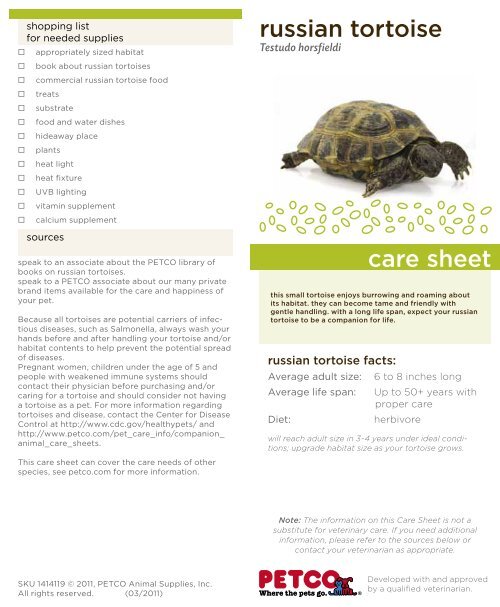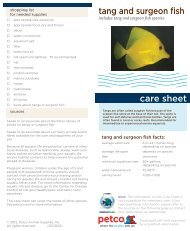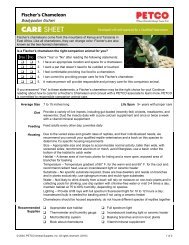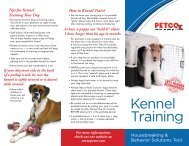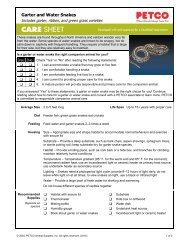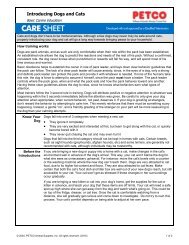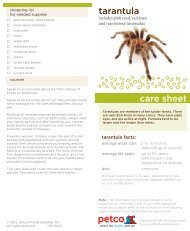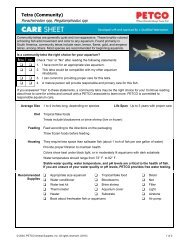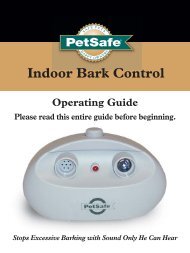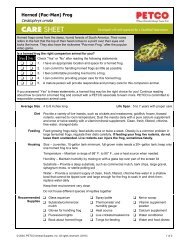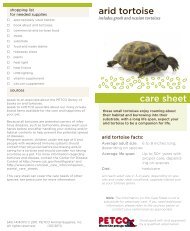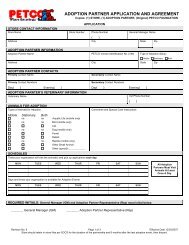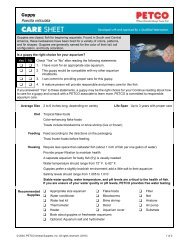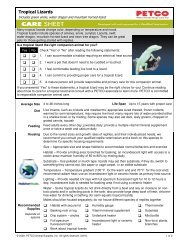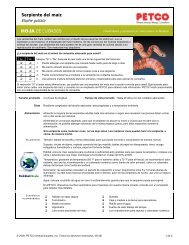russian tortoise care sheet - Petco
russian tortoise care sheet - Petco
russian tortoise care sheet - Petco
Create successful ePaper yourself
Turn your PDF publications into a flip-book with our unique Google optimized e-Paper software.
shopping list<br />
for needed supplies<br />
<br />
appropriately sized habitat<br />
<br />
book about <strong>russian</strong> <strong>tortoise</strong>s<br />
<br />
commercial <strong>russian</strong> <strong>tortoise</strong> food<br />
<br />
<br />
<br />
<br />
<br />
<br />
<br />
<br />
<br />
<br />
treats<br />
substrate<br />
food and water dishes<br />
hideaway place<br />
plants<br />
heat light<br />
heat fixture<br />
UVB lighting<br />
vitamin supplement<br />
calcium supplement<br />
sources<br />
speak to an associate about the PETCO library of<br />
books on <strong>russian</strong> <strong>tortoise</strong>s.<br />
speak to a PETCO associate about our many private<br />
brand items available for the <strong>care</strong> and happiness of<br />
your pet.<br />
Because all <strong>tortoise</strong>s are potential carriers of infectious<br />
diseases, such as Salmonella, always wash your<br />
hands before and after handling your <strong>tortoise</strong> and/or<br />
habitat contents to help prevent the potential spread<br />
of diseases.<br />
Pregnant women, children under the age of 5 and<br />
people with weakened immune systems should<br />
contact their physician before purchasing and/or<br />
caring for a <strong>tortoise</strong> and should consider not having<br />
a <strong>tortoise</strong> as a pet. For more information regarding<br />
<strong>tortoise</strong>s and disease, contact the Center for Disease<br />
Control at http://www.cdc.gov/healthypets/ and<br />
http://www.petco.com/pet_<strong>care</strong>_info/companion_<br />
animal_<strong>care</strong>_<strong>sheet</strong>s.<br />
This <strong>care</strong> <strong>sheet</strong> can cover the <strong>care</strong> needs of other<br />
species, see petco.com for more information.<br />
<strong>russian</strong> <strong>tortoise</strong><br />
Testudo horsfieldi<br />
<strong>care</strong> <strong>sheet</strong><br />
this small <strong>tortoise</strong> enjoys burrowing and roaming about<br />
its habitat. they can become tame and friendly with<br />
gentle handling. with a long life span, expect your <strong>russian</strong><br />
<strong>tortoise</strong> to be a companion for life.<br />
<strong>russian</strong> <strong>tortoise</strong> facts:<br />
Average adult size: 6 to 8 inches long<br />
Average life span: Up to 50+ years with<br />
proper <strong>care</strong><br />
Diet:<br />
herbivore<br />
will reach adult size in 3-4 years under ideal conditions;<br />
upgrade habitat size as your <strong>tortoise</strong> grows.<br />
Note: The information on this Care Sheet is not a<br />
substitute for veterinary <strong>care</strong>. If you need additional<br />
information, please refer to the sources below or<br />
contact your veterinarian as appropriate.<br />
SKU 1414119 © 2011, PETCO Animal Supplies, Inc.<br />
All rights reserved. (03/2011)<br />
Developed with and approved<br />
by a qualified veterinarian.
<strong>care</strong> <strong>sheet</strong><br />
<strong>russian</strong> <strong>tortoise</strong><br />
Testudo horsfieldi<br />
Developed with and approved<br />
by a qualified veterinarian.<br />
diet<br />
a well-balanced <strong>russian</strong><br />
<strong>tortoise</strong> diet consists of:<br />
• high fiber and calcium,<br />
low in protein and fat is<br />
needed to ensure good<br />
digestive tract function.<br />
• dark leafy vegetables,<br />
squash, carrots, etc.;<br />
fruit should be given<br />
sparingly as a treat.<br />
• also benefit from<br />
a <strong>russian</strong> <strong>tortoise</strong><br />
commercial diet, but<br />
should be no more than<br />
25% of the diet.<br />
feeding<br />
things to remember when<br />
feeding your <strong>russian</strong><br />
<strong>tortoise</strong>:<br />
• fresh, clean, chlorinefree<br />
water should be<br />
available at all times.<br />
• feed <strong>tortoise</strong>s daily;<br />
chop vegetables.<br />
• sprinkle food with<br />
calcium supplement<br />
daily and a multivitamin<br />
supplement<br />
once or twice a week.<br />
• discard vegetables and<br />
fruits not eaten within<br />
24 hours.<br />
housing<br />
• size - indoor enclosure<br />
should be at least<br />
36”x12”; outdoor<br />
enclosure should be at<br />
least 48”x48” with a<br />
secure screened cover<br />
to allow sunshine but<br />
provide protection,<br />
the walls should be<br />
high enough that the<br />
<strong>tortoise</strong> can’t escape<br />
and buried at least 12”<br />
into the ground, as they<br />
will dig.<br />
• habitat - keep habitat<br />
arid and dry, with<br />
shaded areas to<br />
escape direct sunlight.<br />
humid climates may<br />
need a dehumidifier,<br />
cool climates require<br />
supplemental heating.<br />
provide a hiding area,<br />
such as a cave or<br />
hide box filled with<br />
additional substrate.<br />
maintain less than 30%<br />
humidity.<br />
• substrate - <strong>tortoise</strong>s<br />
are known for<br />
eating substrate,<br />
use something that<br />
is digestible such as<br />
alfalfa pellets; substrate<br />
should be deep enough<br />
for the <strong>tortoise</strong> to<br />
burrow. don’t use<br />
coarse substrates such<br />
as sand or gravel that<br />
can scratch the shell.<br />
• temperature -<br />
temperature gradient<br />
(85°F for the warm end<br />
and 75°F for the cool<br />
end); recommend using<br />
an incandescent light<br />
or ceramic heater as<br />
primary heat source.<br />
• lighting - providing<br />
UVB lighting for 12-14<br />
hours a day is required.<br />
• <strong>russian</strong> <strong>tortoise</strong>s can<br />
be kept together but<br />
do not house different<br />
<strong>tortoise</strong> species<br />
together.<br />
normal<br />
behavior<br />
active, friendly and outgoing<br />
will become tame with<br />
gentle handling and time;<br />
move slowly around <strong>tortoise</strong>s<br />
to avoid startling<br />
them.<br />
adept at digging to escape;<br />
hide in objects and<br />
burrow into substrate.<br />
common health issues<br />
habitat<br />
maintenance<br />
thoroughly clean the<br />
habitat at least once a<br />
week: place <strong>tortoise</strong> in<br />
a secure habitat; scrub<br />
the tank and furnishings<br />
with a 3% bleach solution;<br />
rinse thoroughly with<br />
water, removing all traces<br />
of bleach smell; dry the<br />
tank and furnishings<br />
completely and add clean<br />
substrate.<br />
grooming<br />
& hygiene<br />
weekly water soaks with<br />
water level no deeper<br />
than the mid-point between<br />
the bottom of the<br />
<strong>tortoise</strong>’s shell and its top.<br />
signs of a<br />
healthy animal<br />
• active and alert<br />
• eats regularly<br />
• healthy shell<br />
• clear, bright eyes<br />
• healthy skin<br />
• clear nose and vent<br />
red flags<br />
• eye, nose or mouth<br />
discharge<br />
• soft, discolored or<br />
rough spots on shell<br />
• lethargic<br />
• bumps or spots on<br />
skin<br />
• abnormal feces<br />
• sneezing, mouth<br />
breathing, runny<br />
nose<br />
If you notice any of these signs, please contact your<br />
exotic animal veterinarian.<br />
Health Issue Symptoms or Causes Suggested Action<br />
metabolic<br />
bone/vitamin<br />
deficiency<br />
respiratory<br />
disease<br />
ticks and mites<br />
gastrointestinal<br />
disease<br />
inability to absorb calcium<br />
due to insufficient UVB light.<br />
if untreated, can lead to a<br />
disorder characterized by<br />
deformities, softened bones,<br />
swollen limbs and lethargy.<br />
labored breathing or runny<br />
nose. can be caused by cold,<br />
damp habitat, or infectious<br />
disease.<br />
consult your exotic<br />
animal veterinarian<br />
and provide ample<br />
UVB lighting.<br />
consult with your<br />
exotic animal<br />
veterinarian and<br />
ensure appropriate<br />
heat levels.<br />
parasites on the skin; can consult your exotic<br />
transmit disease.<br />
animal veterinarian.<br />
runny stools, caked or consult with your<br />
smeared stool around the exotic animal<br />
vent area, and loss of appetite veterinarian.<br />
cause by bacterial or parasitic<br />
infection.


